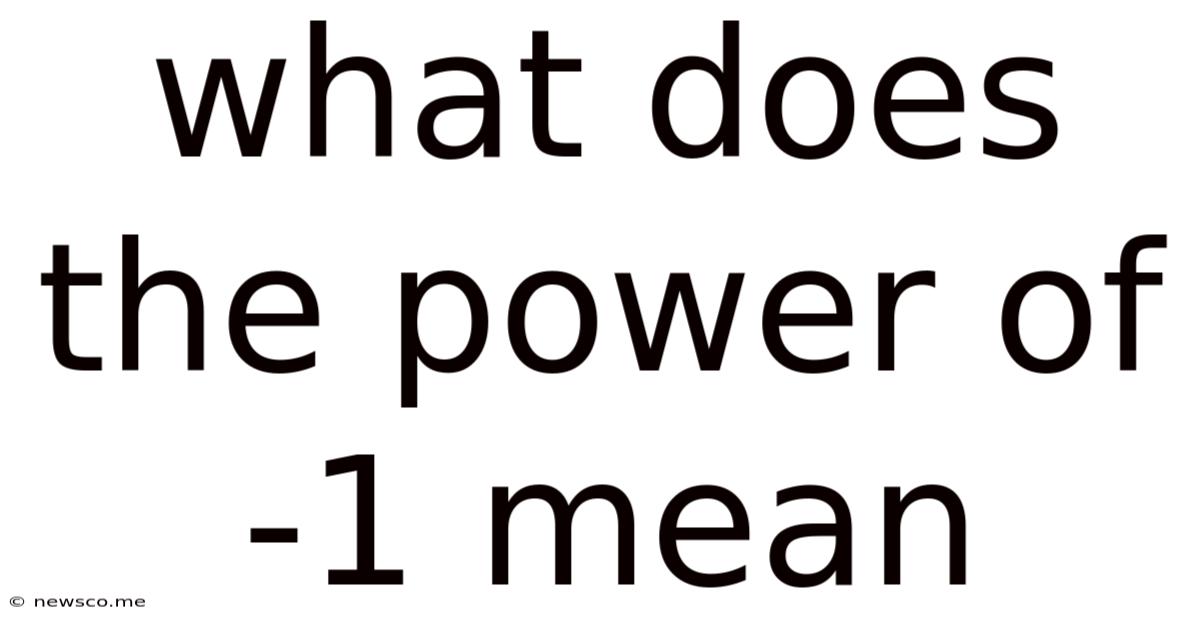What Does The Power Of -1 Mean
News Co
Apr 21, 2025 · 4 min read

Table of Contents
What Does the Power of -1 Mean? A Deep Dive into Negative Exponents
The concept of raising a number to a negative power might seem confusing at first glance. While positive exponents represent repeated multiplication, negative exponents introduce a fascinating twist that expands our understanding of mathematical operations. This article will delve into the meaning of the power of -1, exploring its implications across various mathematical contexts and unraveling its seemingly counter-intuitive nature.
Understanding Exponents: A Quick Refresher
Before we tackle negative exponents, let's solidify our understanding of the basics. An exponent, also known as a power or index, indicates how many times a base number is multiplied by itself. For example:
- 3² = 3 x 3 = 9 (3 raised to the power of 2, or 3 squared)
- 5³ = 5 x 5 x 5 = 125 (5 raised to the power of 3, or 5 cubed)
- x⁴ = x x x x x (x raised to the power of 4)
The key takeaway here is that a positive exponent represents repeated multiplication. But what happens when the exponent is negative?
Deconstructing the Power of -1: The Reciprocal
The core concept behind negative exponents is the reciprocal. The reciprocal of a number is simply 1 divided by that number. For example:
- The reciprocal of 2 is 1/2.
- The reciprocal of 5 is 1/5.
- The reciprocal of x is 1/x.
A number raised to the power of -1 is equivalent to its reciprocal. This is the fundamental definition of a negative exponent with a power of -1.
x⁻¹ = 1/x
This seemingly simple equation unlocks a deeper understanding of negative exponents. It signifies that raising a number to the power of -1 is not about repeated multiplication, but rather about transforming the number into its inverse, its fractional counterpart.
Extending the Concept: Negative Exponents Beyond -1
While the power of -1 provides the foundational understanding, the concept extends to any negative integer exponent. The general rule is:
x⁻ⁿ = 1/xⁿ
This means that a number raised to a negative exponent is equivalent to 1 divided by that number raised to the positive value of the exponent. Let's illustrate with examples:
- 2⁻² = 1/2² = 1/4
- 5⁻³ = 1/5³ = 1/125
- x⁻⁴ = 1/x⁴
This rule consistently applies regardless of the base number (whether it's an integer, a fraction, or a variable).
Applications of Negative Exponents: Real-World Examples
Negative exponents aren't just abstract mathematical concepts; they have practical applications across numerous fields:
1. Scientific Notation:
Scientific notation utilizes negative exponents to represent extremely small numbers. For instance, the diameter of an atom might be expressed as 10⁻¹⁰ meters. This concisely conveys a value that would be cumbersome to write in standard decimal notation.
2. Physics and Engineering:
Negative exponents frequently appear in physics and engineering equations describing phenomena such as radioactive decay, electrical resistance, and wave behavior. They allow for elegant representation and manipulation of complex relationships.
3. Finance and Economics:
In finance, negative exponents can be used to calculate the present value of future cash flows, discounting future earnings to their present-day equivalents. This is a crucial element in investment analysis and financial modeling.
4. Computer Science:
In computer science, negative exponents are employed in algorithms related to data structures and computational complexity. The analysis of algorithm efficiency often involves expressing time or space requirements with negative exponents.
Negative Exponents and the Laws of Exponents
Negative exponents seamlessly integrate with the established laws of exponents. This consistency makes them a powerful tool in simplifying complex expressions.
1. Product of Powers: xᵐ * xⁿ = xᵐ⁺ⁿ (This rule holds true even if m or n are negative)
2. Quotient of Powers: xᵐ / xⁿ = xᵐ⁻ⁿ (Again, applicable with negative exponents)
3. Power of a Power: (xᵐ)ⁿ = xᵐⁿ (This rule is also consistent for negative exponents)
By understanding these laws in conjunction with negative exponents, you can efficiently manipulate and simplify a wide range of algebraic expressions.
Addressing Common Misconceptions
Several misconceptions frequently surround negative exponents:
1. Negative exponent doesn't mean a negative number: The exponent simply indicates the reciprocal operation; the result can still be a positive number. For example, 2⁻² = 1/4, which is positive.
2. It's not about repeated subtraction: Unlike positive exponents which are repeated multiplication, negative exponents are about reciprocals, not repeated subtraction. This is a crucial distinction to grasp.
3. Zero as a base: Raising zero to a negative exponent is undefined. This stems from the reciprocal nature of negative exponents – you can't divide by zero.
Conclusion: Mastering Negative Exponents
Understanding the power of -1, and negative exponents in general, is pivotal for mastering algebraic manipulation and successfully navigating a multitude of scientific and technical applications. While it may initially appear counterintuitive, the concept is fundamentally grounded in the idea of reciprocals. By grasping this core principle and applying the laws of exponents, you'll unlock a powerful toolset for solving complex problems and expressing mathematical relationships with clarity and precision. The seemingly enigmatic world of negative exponents reveals its elegance and utility with careful study and practice. Through consistent application, it transforms from a source of confusion into a valuable asset in your mathematical toolkit. Remember, practice is key to solidifying your understanding and applying this crucial mathematical concept effectively.
Latest Posts
Related Post
Thank you for visiting our website which covers about What Does The Power Of -1 Mean . We hope the information provided has been useful to you. Feel free to contact us if you have any questions or need further assistance. See you next time and don't miss to bookmark.